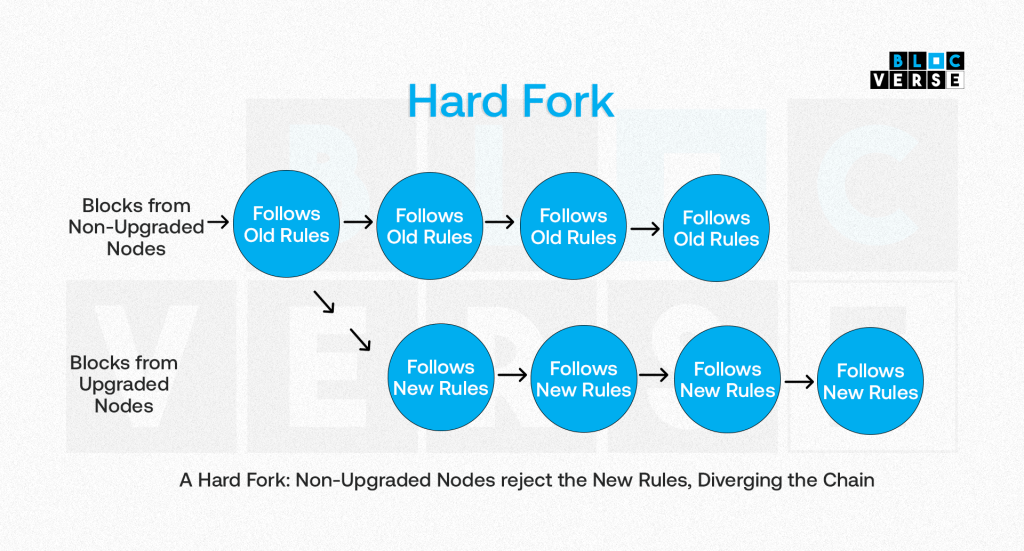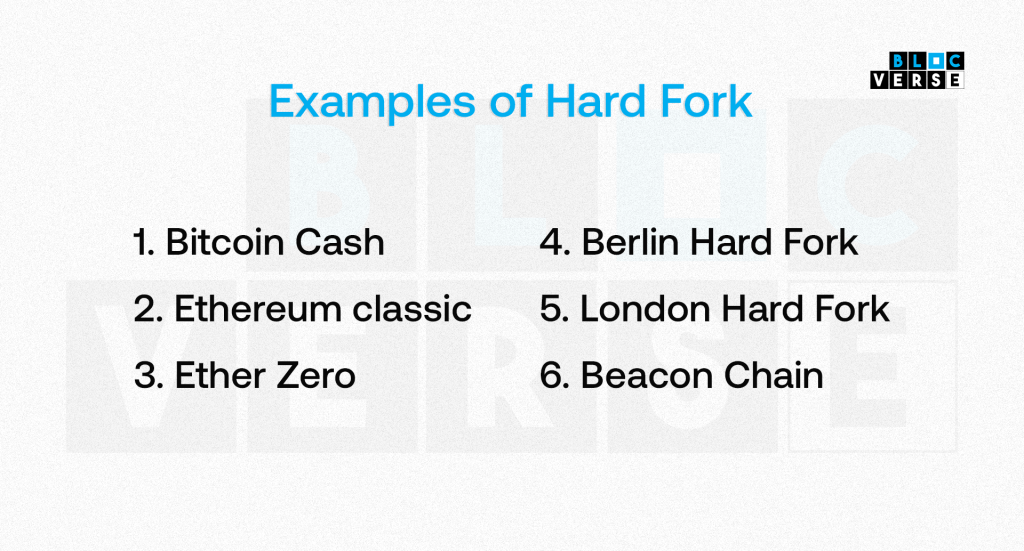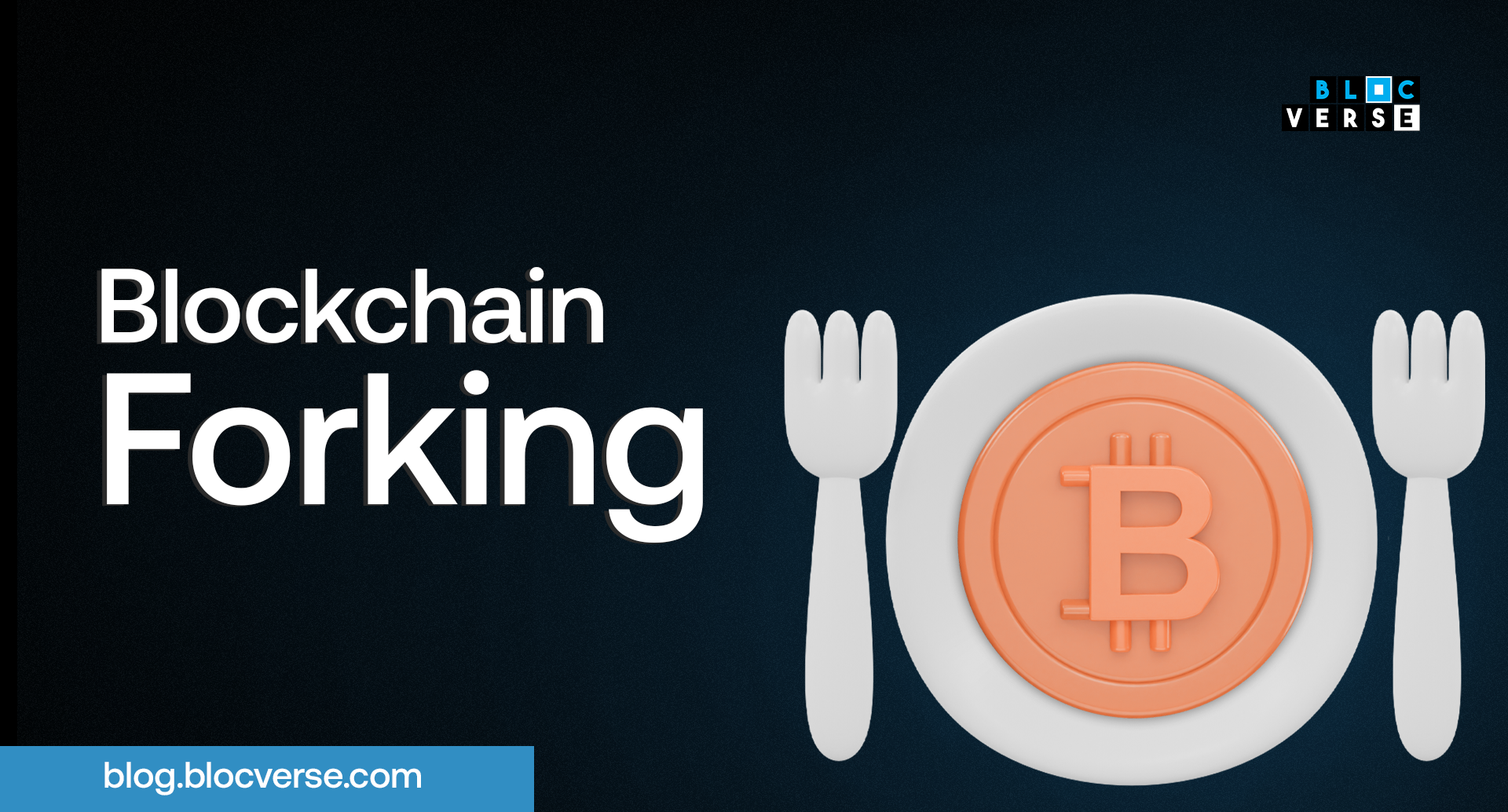INTRODUCTION
We all enjoy updates; at least, the majority of us do.
The new features are a breath of fresh air, and they fix long-standing issues while introducing brand-new ones.
While cryptocurrency networks are decentralised, they can still be improved.
Forks are changes to the blockchain’s network algorithm that cause the leading blockchain network to divide.
An old blockchain network with cryptocurrency running on it can fork, creating a parallel token on the newly created blockchain network.
In this article, the concept of Blockchain forks will be discussed, and the different types and their examples.
TABLE OF CONTENTS
WHAT ARE BLOCKCHAIN FORKS?
Forks in the blockchain network are essentially divisions in the network. The network’s source code is open source and available for free.
This implies that the code can be altered and changes suggested by anyone.
A key component of cryptocurrencies is the ability to experiment with open-source software, making upgrading the blockchain easier.
As the software of various miners diverges, forks happen. Moving forward, the choice of which blockchain to use is left to the miners.
The blockchain may be split into two different versions if there isn’t a unanimous decision.
Around such occurrences, there may be times of greater price volatility.
HOW DOES FORKING WORK IN BLOCKCHAIN

- Forks operate by applying modifications to the blockchain’s software protocol. They frequently link new token production to them.
- Creating new cryptocurrencies from scratch is the primary method of doing so.
- Another viable method would be to “fork” a coin’s blockchain already in use.
- The most frequent approach is to start fresh with token creation.
- Using this technique, old code is “copied and pasted,” updated, and launched as a new token.
- People need to be persuaded to use the new cryptocurrency, and the network needs to be built from the ground up.
Litecoin, which first started as a bitcoin clone, illustrates this technique. - The code was altered by the founders, which convinced people to accept it, and it has since gained popularity as a cryptocurrency.
- A different approach is to fork the current blockchain. This approach modifies the current blockchain rather than creating a new one.
- In this instance, the network splits, resulting in the creation of two distinct blockchains. The invention of bitcoin cash serves as an illustration of this.
- The initial cryptocurrency, bitcoin, was replaced with a new one (bitcoin cash) due to conflicting predictions about its future (bitcoin).
BLOCKCHAIN HARD FORKS VS SOFT FORKS

Forks come in two different types. The hard fork and the soft fork.
Let’s take a look at the hard fork:
HARD FORK

During a hard fork, the blockchain’s rules are updated or changed, rendering the older and newer blockchain incompatible.
This indicates that the old nodes will reject the newly updated blocks and that the newer blockchain will operate according to new rules that perpetually reject blocks from the old blockchain.
This technique is usually referred to as a “backwards-incompatible” software upgrade.
For instance, the Bitcoin community disagreed on the best method for scaling the blockchain network, leading to the development of a hard fork on the Bitcoin blockchain network.
On one side of the issue were those who wanted to increase the block size.
On the other hand, the community members who opposed such reforms prevailed.
Those who wanted to increase the block size joined the Bitcoin Cash fork, while those who wanted to stay on the original Bitcoin network did not.
As a result, even though Bitcoin and Bitcoin Cash operate on different blockchains, their prior histories are identical.
SOFT FORK

A soft fork is a rule adjustment that is forward-compatible as opposed to a hard fork, which is a blockchain upgrade that is backwards incompatible.
Since the split is a forward-compatible change, the old blockchain will continue to accept blocks from the new advanced blockchain platform even though the rules have changed due to the new upgrade.
Generally, a soft fork gets the old blockchain network to agree to the new rules, allowing the new and the old blocks of transactions to be accepted simultaneously.
A soft fork, as opposed to a hard fork, maintains the previous blockchain by maintaining two lanes with distinct rules and standards.
A successful example of a soft fork is the 2015 Segregated Witness (SegWit) Bitcoin protocol upgrade.
Before the SegWit upgrade, the Bitcoin system was somewhat more expensive ($30 per transaction) and time-consuming.
In addition, signature information makes up roughly 65 per cent of a transactional block, according to the developers of the SegWit upgrade.
As a result, SegWit advocated that the effective block size be increased from 1MB to 4 MB.
This enhancement aimed to separate or remove signature information from transactional data records on each blockchain block, freeing more room for more transactions to occur in each block.
With the execution of a soft fork, the prior Bitcoin network was prepared to accept brand-new 4MB and 1MB blocks concurrently.
The soft fork also made it possible for the old nodes to validate the new blocks because of clever engineering that structured the new rules without breaking the old ones.
WHY DO BLOCKCHAIN HARD FORKS HAPPEN?
Developers may implement a hard fork for a variety of reasons, some of which include:
ADDRESSING SECURITY FLAWS
Cryptocurrency hard forks can be used to fix security flaws in protocols, add new functionality or features, alter transaction fees or mining incentives, and speed up or slow down the validation of a blockchain’s transactions.
Crucially, hard forks can aid smaller blockchains in undoing harmful transactions when bad actors defrauded or were hacked to steal money from consumers.
The development of the new Ethereum chain following the disastrous $150 million hack of the old chain, now known as Ethereum Classic, in 2016 as a result of security flaws, is the most noteworthy example of such a reverse.
The Ethereum Foundation launched a fresh update that undid the further illegal transactions carried out by the DAO hackers in order to recover the victims’ assets.
The hard fork that generated Bitcoin Cash in 2017 is unquestionably the most well-known. When Bitcoin Cash miners updated to a protocol version that boosted the block size from 1MB to 8MB, a protracted community disagreement reached a boiling point.
Due to this, Bitcoin and Bitcoin Cash currently exist as two very separate blockchains that serve various communities and have their own laws and goals.
ADDING NEW FUNCTIONALITY
It may be necessary to create a hard fork in order to improve the blockchain protocol, make it more competitive, or even make it cross-compatible with other blockchains.
Of course, community developers frequently disagree on the improvements to their cryptocurrency project, and occasionally these differences are too great to be resolved without creating separate iterations of the same cryptocurrency.
Developers of blockchain technology and digital assets are constantly creating new features that enhance the security, scalability, and stability of the protocol’s open-source software.
In some circumstances, a straightforward network update is insufficient, and a significant rewrite of the current code is necessary.
Here, newer mobile devices or video game consoles are an excellent example because they frequently do not work with older games or programs.
ROLLBACK/REVERSE TRANSACTIONS
A typical example of this would be the case with the Ethereum blockchain’s hard fork to roll back the hack on the Decentralized Autonomous Organization (DAO).
Following the attack, practically everyone in the Ethereum community voted in favour of a hard fork to undo the transactions an unidentified hacker had used to siphon out transactions totalling tens of millions of dollars in digital currency.
Also, the hard fork assisted in returning ether (ETH) funds to DAO token holders. Not all network transactions were rolled up into the hard fork proposal.
Instead, it moved the DAO-related cash to a brand-new smart contract that was only intended to enable fund withdrawal for the original owners.
DAO token owners could withdraw ETH at a ratio of roughly 1 ETH for every 100 DAO.
To offer “failsafe protection” for the organisation, the DAO curators withdrew and distributed any other token balance and ether that remained after the hard fork.
EXAMPLES OF BLOCKCHAIN HARD FORKS

Some of the most common examples of hard forks are:
BITCOIN CASH
In August 2017, this forked from Bitcoin. The block size limit was increased by the Bitcoin Cash fork from 1 to 8 MB and then to 32 MB.
ETHEREUM CLASSIC
This was established in October 2016 as a result of a group of developers rejecting new regulations that had been applied through a hard fork.
As an alternative, they decided to continue utilizing the previous Ethereum blockchain, which was called Ethereum Classic.
ETHER ZERO
The Ethereum network’s transaction processing times will be accelerated via EtherZero. Additionally, this Ethereum split is committed to making these transactions costless in every way.
These are seen by many in the bitcoin community as rather audacious goals.
EtherZero is likewise a “Proof of Work”-based fork; hence the only way to mine it effectively would be with GPU-based equipment.
Nevertheless, it is important to note that this Ethereum fork will eventually have a master node (“Proof of Stake”) architecture.
BERLIN HARD FORK
A network upgrade known as the Berlin hard fork includes four Ethereum Improvement Proposals (EIPs) that change gas costs and permit new transaction types.
The update serves as a prelude to the much larger London hard fork, which will activate EIP 1559, a significant (and divisive) modification to Ethereum’s fee system.
LONDON HARD FORK
Following Berlin in July will be London, which is anticipated to adopt EIP-1559, a proposal that will decrease the supply of ether.
For a transaction to be put to the blockchain, the network would determine the fee itself and then burn it in place of the user submitting a gas fee to a miner.
There are worries that this will reduce the rewards for miners, but it also has the potential to increase the value of ether by reducing the available supply.
BEACON CHAIN
At the centre of Ethereum 2.0 is the Beacon Chain, which organizes the shard chains and holds and controls the registry of validators.
At 12 o’clock UTC on December 1, 2020, the Beacon Chain became live.
A brand-new proof-of-stake blockchain is called The Beacon Chain.
The new network’s coordinating mechanism is in charge of producing new blocks, ensuring their validity, and compensating validators with ETH for maintaining network security.
Proof-of-stake addresses some of the drawbacks of proof-of-work blockchains, including accessibility, centralization, and scalability.
It has long been on Ethereum’s roadmap.
Instead of requiring energy from miners to validate blocks, randomly chosen validators (each of whom has a stake of 32 ETH) suggest new blocks that are then decided by the other validators.
CONCLUSION
Hard and soft blockchain forks are essential for blockchain networks to succeed in the long run. Despite the absence of a centralised authority, they let us upgrade and adapt decentralised systems.
Thanks to forks, blockchains and cryptocurrencies can incorporate new features as they’re built.
We would require a centralised system with top-down control if these processes didn’t exist. Otherwise, the protocol would always be governed by the same set of rules.

